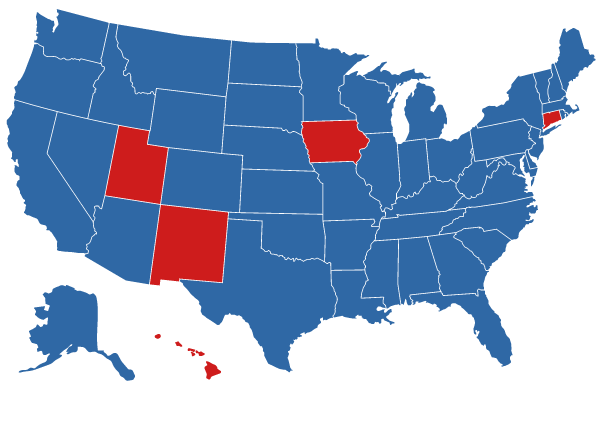The Central Brain Tumor Registry of the United States (CBTRUS) is a not-for-profit research corporation, recognized by the international research community as the premier resource for annual histology-specific statistical information for all primary brain and other CNS tumors in the United States.
The CBTRUS analytic database has been developed by compiling data from central (state) cancer registries, the District of Columbia, and Puerto Rico that include information on both malignant and non-malignant primary brain and other CNS tumors. Non-malignant brain and other CNS tumors include those tumors with a benign behavior code of “0” or uncertain behavior code of “1” as listed in the International Coding for Diseases of Oncology, Third Edition (ICD-O).
The cancer registries that contribute to the CBTRUS database belong to and report to the National Program of Cancer Registries (NPCR of the Centers for Disease Control and Prevention (CDC). CBTRUS combines data from 48 of these central cancer registries with data from four central cancer registries from the Surveillance, Epidemiology and End Results Program (SEER) of the National Cancer Institute, which is part of the National Institutes of Health (NIH).
Reports produced by CBTRUS are published as Supplements to the Society for Neuro-Oncology’s journal, Neuro-Oncology. Since 2012 these reports have been available as a Free-to-View web publication through a link to Oxford University Press from the Reports and Tables section of this website, where it can be downloaded, thereby providing the ability to easily search text, tables, and figures. The CBTRUS reports continue to be among the most-cited publications of Neuro-Oncology, which currently has an impact factor of 15.9.
In addition to its annual statistical reports, CBTRUS produces targeted reports investigating the population-based incidence and survival rates of specific age groups by histology, behavior, site, sex, race, and Hispanic origin. It also provides a Fact Brochure highlighting overall statistics on incidence, survival, mortality, and prevalence, and Fact Sheets focused on specific populations for scientific and patient conferences. Many of the topics featured in its posters and presentations have resulted in publications. The CBTRUS team serves as a resource to the brain tumor community, especially the research community, for example by providing statistical information to support grant proposals and responding to specific questions or studies, including clinical trials, clinical outcomes research, or cluster investigations. CBTRUS provides a reporting standard that serves as a guide globally.
CBTRUS was incorporated with a founding and sustaining grant from the Pediatric Brain Tumor Foundation in 1992 following a two-year study conducted by the American Brain Tumor Association to determine the feasibility of a central registry for all primary brain tumor cases in the United States. Until that time, standard data reporting in the United States had been limited to malignant cases only. Non-malignant brain tumors, however, may–and often do–impose the same costs to society in terms of medical care, case fatality and lost productivity as do malignant brain tumors. A histologically non-malignant brain tumor may produce devastating effects based on its location, while a malignant tumor may not produce visible symptoms. In addition, as molecular markers have been discovered, it has become clear that certain non-malignant brain tumors may become malignant over time.
Passed in 2002, Public Law 107-260 required NPCR to expand their primary brain tumor data collection to include tumors of benign and uncertain behavior beginning with cases diagnosed January 1, 2004. Data from state cancer registries belonging to CDC’s NPCR and agreeing to participate in CBTRUS were made available in 2012 under a special arrangement with CDC/NPCR and are included in the CBTRUS Statistical Report Supplement. SEER data are obtained from their public-use dataset and are appended by the CBTRUS team to the NPCR data for data analysis. The NPCR and SEER data are the foundation of the CBTRUS incidence data.
The most recent report, The CBTRUS Statistical Report: Primary Brain and Other Central Nervous System Tumors Diagnosed in the United States in 2016-2020 continues the most recent efforts CBTRUS has made to provide accurate, population-based incidence rates for all primary brain tumors by histopathology, behavior, site, age, sex, race, Hispanic origin, and geographic regions of the US. These data have been listed in histopathology groupings with improved clinical relevance. They are useful for surveillance and may serve as a baseline for comparison with regional rates. They are also important for allocation and planning of specialty healthcare services, for planning programs for disease prevention and control, and in the development of research proposals. CBTRUS believes that these data may lead to clues that will stimulate research into the causes of this terrible disease.
CBTRUS is a sustaining member of the North American Association of Central Cancer Registries (NAACCR), a member of the Society for Neuro-Oncology, the National Cancer Registrars Association, the International Association of Cancer Registries, and a founding partner of the Brain Tumor Epidemiology Consortium. It contributes its expertise on brain tumor classification, coding, and collection to national and international organizations including the International Agency for Research on Cancer of the World Health Organization.
In 2017, CBTRUS championed the inclusion of the molecular markers found in the histology/biomarker classification of the 2016 WHO Classification of tumors of the Central Nervous System in cancer collection practices in the United States. This practice was implemented starting January 1, 2018. CBTRUS is reported these data in 2019 for the first time. After a 2-year effort, CBTRUS’ petition to include the molecular markers found in the 2021 WHO Classification of Tumors of the Central Nervous System was approved as was its petition to code histopathologies directly to the pons location to enable estimates of the incidence of Diffuse Intrinsic Pontine Gliomas. Collection of both these new cancer registration standards will begin January 1, 2024.
CBTRUS acknowledges the efforts of the tumor registrars at hospitals and treatment centers, the central (state) cancer registries and the cancer surveillance community—NAACCR, NPCR, and SEER—whose efforts to collect accurate and complete cancer data have contributed to advancing research and the treatment of patients, which motivates our work.

